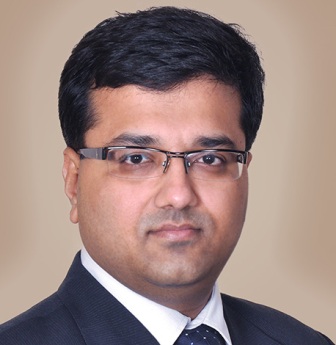 Prashanth Pimple is the SeniorFund Manager – Fixed income, Reliance Mutual fund. He has been with Reliance Mutual Fund for over a decade, managing fixed income portfolios for the fund house.Pimple manages eight debt schemes — Reliance ETF Long Term Gilt, Reliance Short Term Fund, Reliance Credit Risk Fund, Reliance Strategic Debt Fund, Reliance Income Fund, Reliance Dynamic Bond Fund, Reliance Gilt Securities Fund and Reliance NiveshLakshya Fund.
Prashanth Pimple is the SeniorFund Manager – Fixed income, Reliance Mutual fund. He has been with Reliance Mutual Fund for over a decade, managing fixed income portfolios for the fund house.Pimple manages eight debt schemes — Reliance ETF Long Term Gilt, Reliance Short Term Fund, Reliance Credit Risk Fund, Reliance Strategic Debt Fund, Reliance Income Fund, Reliance Dynamic Bond Fund, Reliance Gilt Securities Fund and Reliance NiveshLakshya Fund.
Prashanth Pimple speaks to Geojit Insights on fixed income market.
- What strategy do you follow in debt fund management which is unique to Reliance and which is helping you in managing the risk reward better?
We follow a two pronged strategy, core portfolio and tactical portfolio. Core portfolio reflects our medium to long term views on interest rates & credit, and tactical portfolio is to take advantage of short term opportunity in the market. The Allocation between Core and Tactical positions depends on the scheme mandates. We don’t believe in taking extreme calls as it leads to increased volatility and disturbs the fund mandate ultimately disappointing investor expectations.
- What are the entry and exit criterion for papers in your portfolio?
We believe in identifying the opportunity earlier, leverage on that opportunity and exit once we are convinced that risk return is unfavourable. Investments are done based on inputs- Liquidity, Macroeconomic and Credit view. This view input is a continuous process for fund management decision making which results in entry and exit decision at a portfolio level. In case of Duration and High Grade funds, the most critical inputs are liquidity, credit spreads, inflation, Fiscal deficit, GDP and many other macroeconomic parameters which helps us in forming a broad interest rate view basis which we decide when to increase or decrease duration.
In case of credit views, we follow a bottoms up approach and pursue a rigorous credit analysis process to assess the credit and structure of exposure and thereby initiate exposure.
- In the current scenario when there are questions on credibility reverberating in the market space, what should an investor assess while choosing a scheme?
In addition to the Fund manager’s credentials and track record it is very important to understand the decision making process of the Mutual fund. Adherence to the mandate of the scheme is very important as this will ensure no negative surprises to investors. Also, investors should consider a diversified portfolio in terms on credit exposure and maturity profile.Especially for the credit oriented schemes, investors should try to emphasise more on the credit infrastructure of the MF i.e. team strength, team experience and teams’ ability to ride across various economic cycles.
- There is a shift in focus from accrual funds to duration schemes due to fear of continued rating downgrades. How should an investor manage this situation?
We strongly feel that credit fund investment is an opportunity currently, considering the improving macroeconomic fundamentals and the high absolute spreads available on credits. Investors who are credit risk averse can also look at high grade schemes in the short term and Banking and PSU space wherein the duration is between 1-3 years as spreads on high grade credits are very attractive. With RBI efforts to support liquidity and low inflation expectations we expect this spreads will contract further.
- For an economy to develop, its cost of capital should inch down. Hence with a strong belief in long term growth story of India, can one take a higher allocation in duration schemes over a medium to long term horizon?
Along with cost of capital, I think availability of credit is an important ingredient for GDP growth. Currently yields are down by almost 100 bps from its peak mainly due to sudden fall in oil prices and RBI OMO. We expect OMO to continue to in the Jan to Mar 2019 quarter too which will support G-Secs yields at around 7% to 7.50% levels. As we are approaching General Election of 2019, there are expectations of populist measures which might impact inflation adversely going into next financial year. Hence we feel that the current fall in G-Sec yield is near its near term low and we expect better opportunity for a medium to long term duration investment in early FY 2020.
- Let’s assume that as Indian markets get mature in coming years, the volatility concerns diminish and rates stabilize. What is your inflation trajectory expectation considering the demographic factors unique to India?
Inflation is bane for low income countries like India. Lower inflation is key to macro stability and formalisation of inflation framework prohibits an excessively loose fiscal policy. In line with RBI’s inflation targeting policy, we expect inflation to remain in tolerable range for India in times to come. In the near term, we expect inflation to inch up from current levels due to fading base effect and expectations of any adverse impact of populist measures like farm loan waiver or increase in MSP of farm produce. We expect CPI to average at 3.90% for FY 2019 and to increase to approx 4.50% to 4.80% range in FY 2020.
- What is your short term assumption on 10 year G-Sec and what are the reasons for it?
I expect 10 year G-Secs to continue its fall further in the near term as long as OMOs continue and inflation and oil prices are subdued. But as we go ahead,I expect inflation to inch up due to fading base effect and due to probable adverse impact of populist measure if any as we near general elections. Going by RBI inflation targeting philosophy,I expect RBI might have less room for monetary accommodation and interest rates might stabilise for an extended period of time. In light of the above expectations,I expect 10 year G-Secs to settle around 7.20% to 7.50% range over 1HFY20.
- If you were to suggest policy measures to address current issues faced by Indian debt market, what would they be?
I think to keep our economic growth momentum intact we need to provide durable liquidity and create a conducive atmosphere for bank credit growth. And I am happy that RBI is taking steps in similar directions.
- For someone with 3 year investment horizon, what debt portfolio would you suggest?
For investors with a 3 year investment horizon, it would depend on the risk appetite of the investor. Credit Risk fund would be suitable for aggressive investors and for conservative investors, high grade funds like Reliance Short Term fund & Reliance Banking & PSU Fund would be apt.










